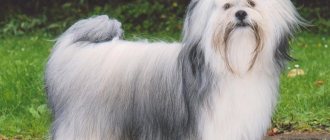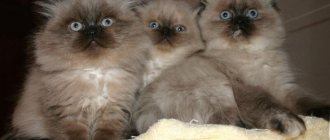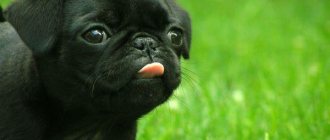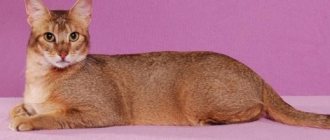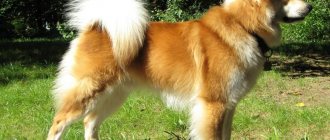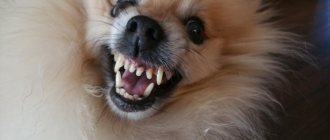- Pets
- >>
- Cat breeds
* Here is a photo of a typical representative of the Kurilian Bobtail cat breed . You can send us photos of your animals by email, and we will post them on the website. Don't forget to send your pet's name.
Other breed names:
Kurbob
Video
* We invite you to watch a video about the Kurilian Bobtail . In fact, in front of you is a playlist in which you can select and watch any of 20 videos about a given cat breed by simply clicking on the button in the upper right corner of the window. In addition, the material contains quite a lot of photos. By looking at them you can find out what the Kurilian Bobtail looks like.
In this article:
|
Rate the material!
[Total votes: 3 Average: 5]
The Kurilian Bobtail is not a new breed, but has been reliably time-tested. Although it has become widespread only since the 90s of the last century, hundreds of nurseries in Russia and abroad are now engaged in it. Cats of this breed are friendly, have excellent health and good working qualities. They can be kept both in city apartments and in villages, where they adapt well to any natural conditions.
Catering
High-quality food for the Kuril Bobtail is the key to a long and healthy life. So remember:
- An adult animal is fed 2 times a day: in the mornings and evenings. You should wash the bowls once a day (do not use any detergents other than laundry soap) and pour clean water at a comfortable temperature into the drinking bowl every day. Kittens 2-5 months old are fed 3-6 times.
- Don't feed your cat from your table. Fatty soups, fried potatoes, chocolate and other favorite foods, unfortunately, are real poison for the animal. Sweet, salty, smoked, sour, canned, flour and baked goods are strictly prohibited.
Natural products
Important diet foods:
- Meat (beef, chicken, turkey, rabbit).
- Fish (both river and sea).
- Plant foods (zucchini, pumpkin, carrots, green salad, asparagus, broccoli, parsley, dill, beans).
- Chicken yolk (boiled), quail eggs.
- Porridge (rice, oatmeal, buckwheat, millet).
- By-products (liver, kidneys, ventricles, hearts).
- Dairy products cause metabolic disruption. The same applies to potatoes, baked goods, dog food, and human canned food. But sprouted oat grains for bobtails are one of their favorite treats.
The water should either be passed through a kitchen filter or left for a day in an open container.
Recommended food
When choosing dry food, buy only food from the holistic group. Applaws, Farmina N&D, Jaguar. Other foods are not suitable for Kurilian Bobtails.
Below are the recommended holistic class foods. Links with the names of the food are clickable, on them you can, within our website, get acquainted with the descriptions of the food and read reviews from owners of Kuril Bobtail cats.
| Holistic | Holistic | Super premium |
| Acana | Go Natural | Organix |
History of the origin of the Kuril Bobtail
The homeland of the Kuril Bobtail, as you might guess, is the Kuril Islands (specifically Kunashir and Iturup). At the end of the last century, this narrowly regional aboriginal breed began to spread in the wake of general interest in new breeds of pets. And joined other similar forms of short-tailed cats - bobtails.
Short-tailed mutations appear in different regions independently, and carriers of this interesting trait become the founders of breeds if they do not have disorders in their genotype that are dangerous to health. This is how a mutant cat once appeared in Japan. The Japanese, great lovers of curiosities, developed a breed of Japanese bobtails, which were brought to the Kuril Islands. Here, in alliance with local cats, they in turn gave birth to more massive and stocky Kurilian bobtails.
The breed was formed in the harsh natural conditions of the islands, with their cold, snowy winters, strong winds, and summer monsoon downpours. Cats have undergone natural selection for endurance and vitality, and in the struggle for existence they have acquired a calm character and excellent hunting skills.
The new breed received recognition only after the development of a standard by Moscow breeder O. Mironova and its acceptance by official organizations. The first breed standard was adopted by the Soviet Felinological Federation (SFF) in October 1991, the latest international standard in 2001. This breed was recognized by international felinological organizations in 1994.
The World Cat Federation (WCF) and the International Organization for the Breeding of New Breeds (FIFe) have approved two varieties of the Kurilian Bobtail depending on the length of their coat: semi-longhair and shorthair. At exhibitions, these forms are evaluated separately.
Origin
The history of bobtails begins on the thresholds of Buddhist temples. There, on the tops of the Himalayan mountains, lived white temple cats, guarding the shrines of the monks. These animals, distinguished by their courage and high intelligence, gradually migrated from the Himalayas to the territories of eastern countries. So, in Japan, keeping such cats at home was an honor; they were groomed and cherished. However, the semi-wild cat nature took over and they left.
The journey brought the temple cats to the Kuril Islands. Outside of human homes, cats took care of themselves. Hunting and the need for defense forced the Japanese Bobtail to change. An increase in size, an unusual color for the ancestor, a lack of fear of water and claws that cats never fully retracted - these are the changes the breed has undergone.
Non-retractable claws are one of the features of bobtails. Thanks to this, today smokers running around the apartment make clicking sounds.
With the arrival of people from Siberia in the Kuril Islands, the bobtails had a new neighbor, with whom he immediately found a common language. The newcomer turned out to be a large, long-haired domestic Siberian cat. Thanks to the union of these two breeds, the modern standard of the Kuril Bobtail emerged.
Kurilian Bobtail - description of the breed
A typical Kurilian bobtail is a hunter cat, whose appearance evokes clear associations with wild representatives of the cat tribe. But the sizes are not particularly impressive: the weight of the cat is 5-7 kg, and the female is even less - 4-5 kg.
Otherwise, a cat of this breed is characterized by:
- Strong, muscular and short body with a slightly arched back and high croup, which resembles a lynx;
- Strong legs, with the hind legs slightly longer than the front ones, and wide round paws;
- Proportional head with rounded triangular outlines;
- Round, dense cheeks and a strong chin;
- Small, spaced ears, rounded at the ends. Tassels are welcome;
- Straight wide nose;
- Eyes set wide apart and slightly slanted, usually yellowish-green in color;
- A tail of 2 - 10 vertebrae, bent in different directions or twisted in the form of a spiral, with a total length of 3 - 8 cm. Looks like a lush pom-pom, thanks to its especially long hair;
- The wool is thin and soft to the touch. In short-haired bobtails, it is correspondingly short on the body, although on the belly and back it is longer and forms “pants.” In semi-longhair - long or medium length, forms a collar and frill on the neck;
- Dense undercoat.
Faults that may cause a reduction in score or disqualification from a show include characteristics that are more common to other breeds and thereby make the boundaries between them blurred.
Disadvantages include:
- Lack of tail;
- A tail whose length is beyond the acceptable limits, as well as short and straight;
- Too massive or, conversely, light body;
- Excessively short front legs;
- Narrow and long head;
- Convex cheekbones;
- A long nose;
- Large and pointed ears;
- Round eyes;
- Lack of undercoat;
- Invalid color.
Origin of the breed
It is believed that the Kuril Bobtail breed appeared independently or with minor human intervention. Their natural habitat is Sakhalin and, as the name implies, the Kuril Islands (mainly Kunashir and Iturup). The latter are a chain of 56 volcanic formations stretching from Kamchatka to Hokkaido.
According to documented information, short-tailed cats have existed in this area for at least the last 200 years. According to one version, they could have gotten to the Kuril Islands from Japan. The country has its own version of this breed, which has lived here for several centuries and is a local symbol of good luck. There is a possibility that the beginning of the Kuril breed was laid by Japanese bobtails that somehow ended up on the islands and went wild. But there is no evidence to support this version.
Another potential ancestor of the breed could be ordinary, yard cats, which came to the islands along with the ancient (V-VII centuries AD) sailors. This hypothesis explains the variety of colors of the species.
Outside their natural habitat, the animals became known thanks to Russian scientists and military personnel who brought them home from the islands. The Kurilian Bobtail cat breed came to the mainland in the 80s of the last century; According to some sources, the arrival of the species on the “mainland” occurred in the 50s. In the early 90s, their selection began in Russia and some former republics of the USSR, and closer to the middle of the decade - in Europe.
Tatyana Botcharova and Liliya Ivanova were among the first to breed bobtails in the Russian Federation. Both encountered problems in the early stages of their work. So, Botcharova took in too many animals, and, due to improper care, her kittens often got sick. Ivanova, on the contrary, worked with such a small number of individuals that inbreeding led to a deterioration in the viability of the offspring. But it was her cats that became the basis for many modern Russian nurseries.
Since 2002, animals have been participating in international exhibitions. The breed is recognized by cat associations in most countries, including the USA and Canada. But it is not yet widespread in North America. “Kurilites” are much more popular in Russia and European countries. The World Cat Federation recognized the breed in 1994.
Appearance
Wild bobtails are small animals whose body, due to their lifestyle, consists of tightly packed muscles. This structure makes the seemingly slender cat unexpectedly heavy. In the natural environment, males, on average, gain up to 4 kg, females - up to 2.5 kg. In nurseries of Kuril bobwhites, larger individuals live - up to 8 kg and 5.5 kg, respectively.
Cat breed Kurilian Bobtail
The average weight of cats of this type is 3-6 kg. Representatives of the species have a wide chest and a large head. They have medium-sized ears and walnut-shaped eyes, oval on top and rounded on the bottom. The color of the latter is in harmony with the shade of the coat. Breeders prefer green, yellow and yellow-green eyes.
One of the distinctive features of the breed is its longer hind legs compared to its front legs. This structure allows animals to make high and long jumps. But the main characteristic feature of the bobtail is the tail, twisted into a kind of “pompom”. The dominant gene in the breed is responsible for its appearance, so all Kuril kittens are born with this decoration. It may seem that your pet's spine ends in a “bump,” but in reality, the segmented body is quite long.
According to standards, the size of the bob (the name of the tail of this breed) is allowed up to 8 cm. It also comes in various shapes, defined by the owners as:
1. Stump. The shortest type of tail. Includes from 2 to 8 tightly connected vertebrae;
2. Panicle. Can be compared to the “stump” (about 30%) of a regular tail. The segmented body consists of 5-10 elements connected at an obtuse angle;
3. Spiral. The longest version of the bob, in terms of the number of vertebrae, can include up to 15 segments. Joined at different angles, they create a variety of structures, such as a pompom sticking out proudly or a hook lying on the back.
4. “Put back.” In this case, only the tip of the tail indicates that it belongs to a bobtail. The main part of 5-7 segments has a normal appearance. Animals with such a tail are not suitable for exhibitions, but, in some cases, are suitable for breeding.
As briefly mentioned above, the Kurilian Bobtail has a variety of colors - the breed has absorbed the entire palette of domestic wool. "plebeian" mousecatchers. You can see red, almost black, striped, creamy beige, “tortoiseshell”, spotted and other individuals.
All these colors comply with international standards. Only some “noble” shades, such as chocolate or cinnamon, are missing from the bobtail palette. Representatives of the “Siamese” pattern are also not present in this form.
The fur of such cats is silky and thick - a gift from life in the cold climate of the Kuril Islands. Hair can be short or semi-long, according to the established classification. That is, representatives of the second group resemble furry pets that do not belong to Persian and similar breeds. They are characterized by the presence of “collars”, “pants” and ear tassels. The latter, together with the tail, enhance the animal’s resemblance to a lynx.
Popular colors of Kuril Bobtails
Kurils can be dressed very differently, although gray-brown striped, spotted and marbled outfits (tabbies), reminiscent of wild ancestors, or bicolors (bicolors) with large spots, like the classic “nobles,” are preferred. Red tabby and tri-color (tortoiseshell) colors are not uncommon. All black and all white specimens are allowed. Colors characteristic of the Abyssinian, Burmese, Thai, Siamese and similar breeds are considered defective.
Such as:
- Color point - with a light body and a dark muzzle, ears, tail and limbs, regardless of color;
- Smooth brown of all shades, for example, like Abyssinians;
- Lilac – the color of coffee with milk, of varying degrees of dilution;
- Cinnamon – cinnamon or light brown color;
- Fawn is a delicate beige color, smooth or with dark stripes and spots.
The color of cats is more a genetic concept than a visual one. For breeders, the combination of genes that determines color is more important than its external expression. For example, an Abyssinian cat, which anyone would call brown or red, is black from a genetic point of view. Because the color of her coat is determined by the gene responsible for the black color. But the red bobtail owes its color to another gene - red.
The white muzzle, chest, belly and “socks” on the paws are very characteristic of smokers. Moreover, on the hind limbs they can well be called “stockings”. Such details are acceptable for any color and pattern of the skin. The eye color should look nice in combination with the color; the most “universal” are green and yellow eyes. For white fluffies and bicolors with a large share of white in color (harlequin, van), sky blue eyes are ideal.
Description and appearance
The bobtail's head is large by standard, wide at the cheekbones. The eyes are oval shaped. Ears tilt forward.
Kurobobs have a rectangular muzzle and whisker pads are clearly visible. The nose is wide at the base, straight in shape, of medium length.
According to the characteristics, females of this breed are larger than males. Females weigh up to 9 kg, males - up to 5 kg.
The bobtail's head is large as standard, wide at the cheekbones
The body is distinguished by strong bones with developed muscle mass. The breed accepts short-haired and semi-long-haired varieties. Any color (black, red, blue, cream, etc.), and the number of white spots varies.
The cat's unusual tail is the calling card of the breed.
There are 4 types of tails:
- Stump - represents 2 vertebrae, fixedly connected to each other.
- Spiral - the tail consists of 3-15 vertebrae, twisting into a kind of spiral. This is one of the most common types.
- Panicle - the vertebrae are located movably or semi-movably among themselves. The tail curves form an obtuse angle.
- Retracted - tail of 5-8 vertebrae, without bends. The vertebrae have varying mobility, the latter forming a spiral at the tip of the tail.
Character and habits of Kurilian Bobtails
Like any native breed, which was formed by uncontrollable conditions of the natural environment, and not by the comfort of a nursery, Kurbobs know how and love to hunt. As island residents, they have mastered fishing, are not afraid of water and are good swimmers. They know how to stand up for themselves when meeting an enemy, but in the house they are affectionate and playful, like any “couch” cats.
This breed easily adapts to new conditions, but is ideal for keeping in a country house, where cats can have fun with their original activities and stay fit. We must not forget that one of the main characteristics of the breed is well-developed muscles.
The Kuril Bobtail breed is considered intelligent. Kittens are inquisitive, active and easily learn all sorts of tricks. For example, they bring a thrown ball. It’s not for nothing that Kurilian Bobtails are said to be cats with a canine character. They become especially attached to the owner of the house, that is, to the one whom they themselves consider the owner. They can go fishing or hunting with him and accompany him on short hiking trips. But they also treat the other inhabitants of the house well, patiently enduring even the antics and noise of small children.
Interesting fact: Cats are friendly and get used to the company of dogs and other non-food animals. If a pair of Kurils of different sexes lives in a house, they form a strong family, remaining faithful to each other even during walks. But there are limits to everything and you shouldn’t try to make friends of these born hunters with birds and hamsters.
Kurbobs are child-loving, and not only their mothers, which would not be surprising. Cats of this breed love kittens no less and can take care of them, licking and playing with the cat. A commendable custom, given the brutal tendencies of most cats, who easily strangle kittens, even their own.
Characteristics of Kurils
It turned out that the Kuril Bobtail combines the character qualities of both a wild ancestor and a domestic cat. But there is no clear line between these features.
This is a friendly, trusting cat
. He easily finds a common language not only with his owner, but also with other cats and dogs. The Bobtail is smart and intelligent. Therefore, if he misbehaves or is drawn to dangerous adventures, it will be enough to have an educational conversation with the pet. Kuril cats can easily tolerate long trips, changes in environment, and interactions with small children.
In addition, short-tailed cats are active and inquisitive animals.
. Their potential is revealed in all its glory in nature. They love to explore open areas, climb trees and fight with neighbor's pets for territory. Breed experts say that bobtails love water and are excellent swimmers. Therefore, you should not be surprised if one day he brings freshly caught fish into the house.
Another important facet of the Kuril Bobtail’s is that it is an intelligent and tireless hunter.
. If a representative of the described breed lives in the house, it means that the person is not at risk of rodent infestation. They say that in nature the catfish catches squirrels, hares and snakes. At the same time, when kittens appear, even stern bobtail cats become gentle and caring parents to their children.
The breed is distinguished by high levels of intelligence. Therefore, you will not have any special problems in training your pet. Kittens are easy to raise and litter box trained.
Interesting facts about Kurilian Bobtails
The tail of any Kuril Bobtail is unique, and when breeding, breeders do not try to achieve uniformity.
There are 4 main types:
- “Stump” - vertebrae number 2-8, very short and closely packed together, the tail is motionless and knobby thickenings - fractures - can be felt on it;
- "Broom" is a more common "model". The vertebrae are connected in a zigzag at obtuse angles to each other. Relatively mobile;
- “Spiral” is a highly deformed tail in which the vertebrae are located at all sorts of angles, even sharp ones. Usually has the shape of a spiral or hook that curves over the back or is adjacent to the sacrum. In places the joints are movable and the cat can even wag its tail;
- “Retracted bobtail” is the same spiral, but located at the end of a straight section of 5-7 vertebrae. The tail is usually relatively long and is considered a defect that reduces show scores.
The first cat to be officially registered as a representative of the new breed was named Chip-O, and the first champion was Ai-ok-a-Kuna. The fact is that at first felinologists did not distinguish the bobtails brought from the Kuril Islands from the already known Japanese ones, so they gave them such exotic names.
Kurbob fans believe that their favorites are able to recognize about 1.5 thousand words and understand individual phrases. By the way, my “yard guy” also perfectly understands several phrases, especially with unprintable words.
The sporting achievements of seals of this breed include the ability to catch fish weighing up to 5 kg, the ability to cope with a powerful rat and jumping to a height of up to 2 m.
Kurbobs are very talkative, and the range of sounds they make is extremely wide. In addition to the banal meowing and yelling during a fight, they can grumble, chirp, and whine like a dog. They usually voice all their actions, especially disgustingly and loudly reporting the discomfort they experience. For example, sitting on your hands.
Breeding
When the question arises about breeding Kuril Bobtails, one must take into account the mandatory requirement of the international felinological standard - a ban on crossing with any other breeds. After all, even the appearance of offspring from parents from different islands (one from Kunashir, and the other from Iturup) can have undesirable results - a tail that is too long or a complete absence of one.
Breeding Kuril Bobtails does not always give the expected results
However, some breeders deliberately bring together cats from different nurseries, explaining this with the desire to avoid inbreeding and add variety to the breed's qualities.
Seals are given for mating at the age of 1 year, but female cats mature a little later - by 1 year and 1 month. However, experienced breeders prefer to untie females only by the age of two, when the cat’s genitals are fully formed.
In order to breed animals, you need to contact the appropriate Kuril Bobtail club. The organization will check the pet’s veterinary passport, pedigree and breeding permit, exhibition diplomas and the purr itself.
Fluffies allowed for crossing:
- not having closely related ties;
- with the same length of wool;
- without diseases;
- with a tail that meets the requirements of the breed standard;
- compatible by blood group (cats have two of them - A and B, the latter is rare).
Mating takes place on the cat's territory 2–3 days after the start of estrus.
A cat's pregnancy lasts 62–66 days, and a litter usually produces five kittens. Each newborn Kurilian has strictly individual features and unique tail curves.
It has been noticed that cats with short tails (of the “stump” type) produce offspring with short tails when crossed with long-tailed cats (of the retracted bobtail or broom type). And the purrs with spiral tails have the most stable genetics.
Castration and sterilization
When a Kurilian Bobtail is purchased only for the joy of the owners without the purpose of breeding, it is better to castrate the animal (remove the internal genital organs) or at least sterilize it (ligate the canals and fallopian tubes).
Castration will help the Kurilian Bobtail cope with its natural reproductive instinct and make the animal even more affectionate
The optimal age for surgery is considered to be before puberty. Most often, Kurils are spayed and neutered when the kittens are 8–12 months old.
The operation is performed under general anesthesia, after which the pet comes to its senses in about 2–4 hours. The final restoration of vital activity occurs only on the second day.
After returning home, you need to carefully monitor the condition of the purr, protecting your pet from hypothermia and drafts. It is also important to monitor your smoker's regular urination.
Pros and cons of Kurilian Bobtails
When you decide to get a pet, you need to find out its needs and behavioral characteristics in advance. This will save you from unnecessary problems. What can you say about Kurilian Bobtails?
The advantages of the breed include:
- Easy adaptability;
- Quick wit and quick learner;
- Activity and playfulness;
- Friendliness, including towards dogs;
- Contact and social loyalty, for example, towards strangers;
- The fact that there is no need for frequent combing of the coat;
- Weak expression of molting;
- Lack of special food preferences;
- Good health (if you choose the right kitten);
- Hunting talent.
Depending on who keeps them and where, the benefits can turn into their opposite. Thus, activity and playfulness in an apartment can damage order and disturb the owner, who is busy with business or simply sick. Moreover, many cats are loud, even loud. Not everyone has time to maintain the vigorous physical condition of a pet, play with it and walk it, take it to the country or just for a country picnic.
Interesting fact: Another problem with apartment living is falling out of a window, which can lead to a cat’s hunting excitement, jumping up at the sight of flying game. Therefore, in the apartment where the bobtail lives, bars on the windows are necessary.
Devotion to the owner obliges the latter not to part with the pet for a long time, who will miss him. Separations do not improve the character of the animal, and it can run wild, become capricious and angry. For those who leave home for a long time, it is better to get a cat of a different breed, one that is not so affectionate. Particular difficulties arise for breeders of Kurils.
How to choose a kitten
Purchasing a Kurilian Bobtail kitten is a responsible step that requires intuition and attentiveness from you! It is important to notice among the frolicking kittens exactly the one who will catch your heart. At the same time, you should not listen to either the words of the breeder or the advice of friends and relatives: this is your pet, so you only need to rely on your own premonitions.
The ideal age for purchasing a Kurilian Bobtail is three months. It is at this time that the baby begins to show independence and gradually weanses the habit of maternal care. In addition, a three-month-old “smoker” already has fairly balanced psychological health, so he quickly gets used to new family members.
If the pedigree of the future pet plays an important role, ask the breeder to introduce you to the necessary documentation or, more preferably, to the parents of the babies. This is one of the easiest ways to understand what to expect from your bobtail. The breeder is not talkative and does not demonstrate a desire to tell as much as possible about his charges? This is an alarming sign: it means he has something to hide from curious and persistent buyers like you.
When choosing a kitten, you should focus on its behavior among its brothers. Is your baby active and cheerful, happily getting involved in play and showing healthy curiosity towards you? This is your pet! Refrain from buying lethargic and timid kittens: this may lead to unpleasant consequences in the future.
Breeding Kurilian Bobtails
Crossing Kurbobs with other breeds is prohibited in order to preserve their originality. Only purebred cats, that is, those with documents, are allowed for breeding. As felinologists say: “No documents - no breed.” The offspring of such parents can receive the status of purebred, but whether they will receive permission to breed or be relegated to the “pet” class, experts at exhibitions will decide.
An exception is made for cats brought directly from the Kuril Islands, Sakhalin and Kamchatka - they are issued a pedigree certificate at an exhibition in the “novice” class after the approval of experts and confirmation of the origin with a whole bunch of certificates. These include a veterinary passport, a transport ticket, photo and video materials proving that the applicant’s parents live in the listed regions.
The breed cannot be called widespread and the reason for this is low fertility. There are usually only 2-3 kittens in a litter. The maximum number - 5 can be obtained with successful selection of partners. The initially low population size led to inbreeding - that is, inbreeding, in which hereditary defects spread. Therefore, it is not uncommon for kittens to be born with defects: excessively short-tailed or tailless, with a coat structure that does not meet the standard.
Interesting fact: Deviations from the standard also appeared thanks to unscrupulous breeders who mated with cats of other breeds and introduced foreign genes into the gene pool of the breed. Therefore, when selecting pairs, a careful study of pedigrees is required.
But basically, breeders have to rely on luck, since the genetics of Kurbobs is poorly studied and genetic laboratories carry out only individual tests (for example, for the presence of an amber “carnelian” color).
It is known that a cat with a “stump” often produces tailless kittens. The tails of the “spiral” are well inherited. It is difficult to predict the results of mating cats with “brooms” and “retracted bobtails”. Bobtails live up to 20 years, which, however, is typical for cats in general. Breeding involves individuals from 2 to 10 years old.
Health of Kuril bob-tailed cats
Since the breed is semi-wild, Russian Bobtails are extremely rarely exposed to diseases. Excellent health helps cats live a long, rich life, whose duration is 15–20 years.
Nature has rewarded Kurilian Bobtails with good health
To maintain immunity and protect against diseases, Kuril cats need to be wormed regularly (at least once every six months) and given mandatory vaccinations.
Vaccination is carried out as follows:
- The first vaccination for a kitten should be done at the age of 8–12 weeks;
- then revaccination is carried out after 3 weeks;
- after which the cat is vaccinated every year at the same time in order to prevent diseases.
It is important to remember that vaccination cannot be carried out when the animal is not healthy or the kitten’s teeth are changing. And two weeks before visiting the veterinarian, your pet needs to be rid of helminths and parasites on the fur (fleas and ticks).
The main vaccines for Kurilian bobtails remain the same ones used for other cats - against rabies, panleukopenia (distemper), respiratory diseases, as well as against leukemia and infectious peritonitis.
Despite the measures taken, representatives of the breed in adulthood can sadden owners with the appearance of certain ailments - inflammation of the mucous membranes of the eyes, problems with urination. And kittens often have difficulty defecating. These are associated with the specific structure of the tail of the Kurilian. Therefore, if the baby behaves restlessly near the tray, you need to examine the pet and remove excess feces from under the tail.
At the same time, the bobtail gene does not in any way affect the health of the furry animal.
Video: vaccination of the Kurilian Bobtail
Caring for Kurilian Bobtails
Kurbob is naturally healthy and if it has no birth defects, it does not require specific care. All the basic rules of keeping that are suitable for any cat are also suitable for him.
First of all, you need to arrange places for him to rest, eat and toilet and keep them clean. A scratching post is also a necessary piece of furniture in a cat owner’s home. Nowadays there are entire sets of houses and various cat utensils on sale, but the cat is not interested in issues of design and fashion, so he will not appreciate the cost of such luxury.
There is an opinion that cats need to be washed, but many people dispute it with furious persistence. We can assume that free-range kurbobs do not wash in bodies of water. Despite the fact that the breed's history includes fishing, a pet unaccustomed to water will greet washing with a scandal. It is logical to let them decide on their own issues of cleaning fur, ears, trimming nails and other hygiene. The fur of the semi-longhaired variety can be combed, and only during the spring molting period.
It is more important to monitor your pet's health. At a minimum, carry out annual comprehensive vaccination against viral diseases and rabies. Not only for walking cats, but also for those that do not leave the apartment, because the infection can be brought from the street on clothes and shoes. For the same reason, once or twice a year it is necessary to deworm domestic cats, and, of course, free-roaming ones.
Education and training classes are not considered mandatory for a cat, but the Kurilian Bobtail will be very happy if you pay attention to it. In addition, training the pet to commands such as “lie down”, “place”, etc. will make it easier to manage. And this is a great achievement in relations with such an animal as a cat.
Features of behavior and character
Kurilian Bobtails do not like to be alone; these pets prefer to constantly “chase” the owner or one of the family members. Other pets living in the same house as the smoker are also subject to surveillance.
Kurilian Bobtails love children and big companies
From their wild ancestors, fluffies have inherited a love of water, which in a city apartment manifests itself in the form of a regularly occurring desire to splash around under an open tap or in a drinking fountain.
Left with bob-tailed pets and the instinct to jump as high as possible. Therefore, in order to avoid injury to the animal and damage to furniture, you need to take care of purchasing special posts with several sections for climbing and resting.
In addition, Kurilian bobtails are excellent rat catchers, and in their natural habitat, both squirrels and hares serve as prey for purrs.
Kittens of the breed are distinguished by their curiosity and sharp mind. Thanks to its developed intelligence, it is easy to teach the smoker the rules of behavior in the house and even simple tricks.
The undoubted advantages of Russian short-tailed cats include:
- protective instinct, the desire to drive away strangers from one’s territory;
- ability to get along with other pets and small children;
- playful and active character;
- good intuition, due to which the animal senses weather changes and natural disasters in advance;
- inability to leave specific marks on walls and furniture;
- love of outdoor trips and travel;
- unpretentiousness and cleanliness.
But many owners say that the disadvantage of the breed is too strong an attachment to a person, a literal pursuit on the heels.
In addition, smokers:
- against the backdrop of the “protector” instinct, they are unmerciful to guests and strangers in the house (they can even attack);
- they do not like cuddling and excessive caresses; they prefer high backs of sofas and doors to sitting on their knees;
- sometimes experience difficulty during bowel movements;
- love to “talk”, making sounds of purring, loud sniffling, growling, creaking, hissing and persistent meowing;
- may cause allergies, especially during molting.
Video: Kurilian Bobtail takes a bath
Diet of Kurilian Bobtails
The diet of kurbobs has no special features in comparison with, say, nobles. Two types of nutrition are also possible for them: natural food and ready-made food. There is no convincing evidence that one type or the other is superior. It all depends on the preferences and beliefs of the owner.
In any case, the diet must be balanced, that is, it must provide the animal with all nutrients and vitamins, be well absorbed and not cause metabolic disorders. With natural feeding, the cat should receive a sufficient amount of meat and sea fish, but always with vegetables or porridge. Some experts do not advise giving this breed milk and potatoes, although there are as many opinions as there are specialists.
Interesting fact: Ready-made food is convenient because it is prepared by cat nutritionists and takes into account their different needs: gender, age, activity. Dietary and medicinal food options that take into account health problems are especially convenient. But in any case, you will have to go through a lot of brands before you find the right one for your animal.
The most convenient option that will suit everyone is a free-roaming cat that is looking for its own prey. But even in this case, it will have to be fed either natural or dried. So that he knows that he is loved. Additives for hair removal are not relevant in the case of kurbobs. Whether it is worth giving them all sorts of treats for cleaning their teeth or vitamins, everyone decides for themselves.
The fact that the food is complete and to the pet’s taste can be judged by the shine and fluffiness of its skin, cheerful mood and activity. When cleaning the tray, it is worth looking into it and assessing the results of feeding: the stool should not be liquefied or too dry. Traces of blood indicate a variety of problems in the body: from cystitis to worms and more serious diseases.
Diseases and health problems
Due to an abnormality of the tail or some other reason, smokers are characterized by inflammation of the anus, hemorrhoids and even prolapse of the rectum. This intimate area needs regular supervision from an early age. If cracks and redness appear, the butt is lubricated with vegetable oil or appropriate veterinary preparations, but the main thing is to reconsider the pet’s diet. Because the cause of the problem may be indigestion. Or worms.
A common disease in cats, especially sedentary domestic cats, is urolithiasis (UCD). Kurilian Bobtails have naturally more acidic urine than other breeds and their UCD is usually of the acidic type. But it is possible to determine exactly what dietary food they need when signs of illness appear after conducting an acidity test. However, there are foods for mixed type urolithiasis.
Advanced KSD often leads to kidney disease, which requires feeding with appropriate food. But for detailed consultations and gaining experience, it is always better to contact a specialist, in this case a veterinarian. The basis for this should be any violation in the pet’s behavior - physical or mental.
Preventive vaccinations against infectious diseases will protect pets from many diseases: viral, including rabies, and skin diseases. Preventive examinations are useful, during which it is useful to check the condition of teeth and vision, which is especially important for older cats - 10 years or more. In general, kurbobs are quite resilient and do not have specific genetic diseases. At least those that have been identified.
Care and maintenance
The Kurilian Bobtail does not require careful grooming - and this is another plus in favor of the breed. Even long-haired bobtails do not cause unnecessary inconvenience to their owners.
Since the undercoat of cats is moderately developed, the coat almost never gets tangled, and the procedure of combing the Kuril Bobtail does not become a daily chore. Once or twice a week is enough. It is recommended to purchase a special brush with metal teeth or a glove with silicone growths to remove dead hair. When combing, follow the direction of hair growth.
Bathing for bobtails is one of the most favorite ways to spend time, but you should not overuse it: the skin becomes dry and the guard hair becomes thinner. Using special mild shampoos and conditioners will not help the situation. You should only bathe your pet if it is dirty. Fill a bowl or sink with warm water and then place the cat there. Apply shampoo to the coat, carefully distribute it over the entire body of the Kurilian Bobtail and rinse. After bathing procedures, the pet must be thoroughly dried. For short-haired cats, a towel cocoon is perfect, but long-haired cats will need a hairdryer.
From their ancestors, Kurilian Bobtails inherited the inability to fully retract their claws. For this reason, they are perfectly worn down both while the pet walks and when it interacts with the scratching post. However, it still doesn’t hurt to get a special device for shortening them. Cut off only the ends, otherwise you will damage the thin vessels.
Don't ignore your pet's eyes. They need to be washed several times a week, using a piece of clean, lint-free cloth or cotton wool soaked in a special product (this can be purchased at a pet store). When rubbing your eyes, move your hand from their outer corner to the inner one. The bobtail's ears should be inspected with a similar frequency, wiping them with a cotton pad soaked in a special lotion. Otherwise, wax will accumulate in the ears, which can later lead to the development of infectious diseases.
When it comes to oral care, brushing your cat's teeth once a week is sufficient. However, the use of “human” pastes is strictly prohibited. Get a special attachment for your finger to make the procedure much easier. Don't forget that if absolutely necessary, you can use a regular toothbrush.
Representatives of this breed are extremely unpretentious eaters, but this does not mean that you can feed your pet table scraps. For a show-class Kurilian Bobtail that regularly participates in exhibitions, it is best to purchase premium food. For breed and pet animals, regular food combined with natural food, in particular boiled meat, is suitable.
The following should not be included in the Kuril Bobtail diet:
- some vegetables: potatoes, legumes, eggplants;
- fish (with the exception of low-fat sea fish);
- raw and fried meat;
- bakery products;
- dairy products;
- pork and lamb;
- tubular bones;
- smoked meats;
- sweets.
There should always be filtered fresh water in your pet's bowl.
